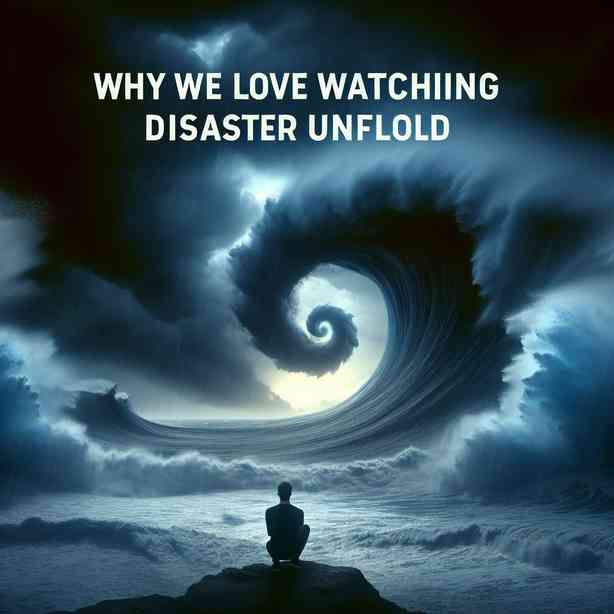
Watching disasters unfold has become a captivating phenomenon in our society. Whether through news channels, documentaries, or reality television, the human tendency to be engrossed in calamities raises intriguing questions about our psychology and societal behaviors. Why do we find ourselves unable to look away when catastrophe strikes? Understanding this fascination requires exploring a complex interplay of factors, including our innate curiosity, emotional responses, cultural narratives, and even evolutionary history.
One of the primary reasons we are drawn to watching disasters is the inherent human curiosity that compels us to seek out the unknown. From a young age, we are naturally inclined to explore our surroundings and understand the mechanisms of how things work. Disasters, by their very nature, are anomalous events that disrupt the norm, which can pique our interest and demand our attention. This curiosity can be likened to a double-edged sword; while it drives knowledge and understanding, it can also lead us to obsess over events that evoke fear and uncertainty.
Moreover, disasters often serve as a lens through which we can reflect on our own vulnerabilities. When we witness a catastrophe, whether natural or man-made, we are confronted with our fragility. This confrontation can lead to a range of emotional responses, from empathy for those affected to anxiety about our own safety. The psychological concept of “vicarious trauma” comes into play here, where we experience emotional distress through the suffering of others. It can foster a sense of connection and remind us of our shared humanity, prompting individuals to contribute to efforts such as aid and relief.
In addition, disasters tend to invoke a myriad of strong emotions, such as fear, sadness, and sometimes even fascination. This emotional rollercoaster can be compelling. Researchers suggest that these heightened emotions can lead to what is known as “emotional arousal,” where viewers react with heightened engagement. When faced with alarming visuals and dramatic narratives, our bodies react physiologically, often releasing adrenaline and other stress hormones. This can lead to a rush of excitement, even in the context of tragedy. In this way, the horror of disasters can evoke a visceral response that captivates an audience.
Cultural narratives significantly influence our fascination with disasters as well. Societal storytelling traditions often feature disaster tropes, wherein calamities serve as pivotal plot points that drive character development and plot advancement. From classic literature to modern cinema, we see characters confronting adversity, which can provide catharsis for audiences. This shared storytelling offers a framework for people to process real-world events and crises, allowing us to engage with these stories in a culturally resonant manner. In effect, disasters serve as fertile ground for mirroring our social anxieties and fears, creating an avenue for communal support and conversation.
On a broader scale, one cannot overlook the impact of media in shaping our perceptions of disasters. The 24-hour news cycle and the advent of social media have allowed for a constant flow of information, presenting disasters in real-time. This immediate access can heighten our anxiety but can also foster a sense of urgency and importance surrounding the event. It encourages viewers to be “in the know,” keeping them engaged as they follow unfolding narratives. This phenomenon has resulted in a news culture where ratings often depend on the dramatic portrayal of events, drawing audiences continually back for more disturbing yet compelling content.
Additionally, our fascination with disasters can often be linked to a phenomenon known as “disaster tourism.” This concept refers to the practice of visiting locations that have experienced catastrophic events, sometimes referred to as “dark tourism.” Individuals are often drawn to these sites out of a desire for firsthand experiences and storytelling. These visits can serve as a form of connection to the events that transpired and can elicit both profound reflection and entertainment. Museums dedicated to disasters, such as 9/11 memorials or Holocaust exhibits, can evoke a sense of solemnity and understanding, inviting an engagement reflective of respect and remembrance.
However, while there is a legitimate interest, it is crucial to maintain a sense of responsibility in consumption and presentation. Media outlets must consider the implications of portraying disasters solely for entertainment purposes, as it can lead to desensitization or further exploitation of tragedies. This can create a moral quandary for consumers as they navigate their own enjoyment versus the potential harm done to communities affected by the featured disasters. The balance between seeking emotional engagement and respecting those who suffer is necessary to forge a more empathetic viewing experience.
Moreover, the social media landscape provides a platform for immediate reactions and commentary on disasters, influencing how we collectively process these events. People often engage by sharing their feelings, offering help, or even criticizing the media narrative. This multifaceted interaction allows for a communal experience that can lead to stronger societal bonds, that comes with both support and shared grief.
As we delve deeper into the reasons behind our obsession with witnessing disasters, it’s important to recognize the potential for learning and growth that can accompany these experiences. Disasters, while devastating, also trigger discussions about preparedness, resilience, and the human spirit’s ability to overcome adversity. By exploring effective strategies for coping and recovery, societies can foster resilience that transcends the catastrophic events themselves.
As we conclude our exploration of why we love to watch disasters unfold, it becomes evident that this phenomenon is complex, rooted in human nature and societal frameworks. From curiosity and emotional responses to cultural narratives and media influences, our fascination with disaster illustrates deeper aspects of human behavior and engagement. While it is essential to acknowledge the responsibility that comes with consuming and portraying these narratives, recognizing their role in our collective consciousness and social discourse could ultimately lead to empathy, understanding, and cohesion. Through shared stories of resilience, we can find pathways toward recovery and hope amidst the unfolding tragedies that define our world.


